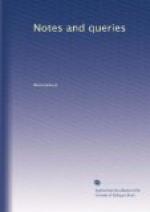There are some difficulties in Dugdale’s account of the Cobham family which it may be well to bring before your readers; especially as several other historians and genealogists have repeated Dugdale’s account without remarking on its inconsistencies. In speaking of a junior branch of the family, he says, in vol. ii. p. 69., “There was also Ralphe de Cobham, brother of the first-mentioned Stephen.” He only mentions one Stephen but names him twice, first at page 66., and again at 69. Perhaps he meant the above-mentioned Stephen. He continues:—
“This Ralphe took to wife Mary Countess of Norfolk, widdow of Thomas of Brotherton. Which Mary was Daughter to William Lord Ros, and first married to William Lord Braose of Brembre; and by her had Issue John, who 20 E. III., making proof of his age, and doing his Fealty, had Livery of his lands.”
At page 64. of the same volume he states that Thomas de Brotherton died in 12 Edward III., which would be only eight years before his widow’s son, by a subsequent husband, is said to have become of age. That he did become of age in this year we have unquestionable evidence. In Cal. Ing. P. Mortem, vol. iv. p. 444., we find this entry:—
“Anno 20 Edw. III.
Johannes de Cobham, Filius et Haeres Radulphi de
Cobeham defuncti. Probatio
aetatis.”
There is also abundant proof that Thomas de Brotherton died in 12 Edward III. The most natural way of removing this difficulty would be to conclude that John de Cobham was the son of Ralph by a previous marriage. But here we have another difficulty to encounter. He is not only called the son of Mary, Countess of Norfolk, or Marishall, by Dugdale, but in all contemporaneous records. See Rymer’s Foed., vol. vi. p. 136.; Rot. Orig., vol. ii. p. 277.; Cal. Rot. Pat., p. 178., again at p. 179.; Cal. Ing. P. Mortem, vol. iii. pp. 7. 10. Being the son-in-law of the Countess, he was probably called her son to distinguish him from a kinsman of the same name, or because of her superior rank. She is frequently styled the widow, and sometimes the wife of Thomas de Brotherton, even after the death of her subsequent husband, Sir Ralph de Cobham. In the escheat at her death she is thus described:—
“Maria Comitissa Norfolc’,
uxor Thome de Brotherton, Comitis Norfolc’,
Relicta Radi de Cobeham, Militis.”
It is remarkable that this discrepancy in Sir John Cobham’s age, and the time of his supposed mother’s marriage with his father, has never before, as far as my knowledge extends, been noticed by any of the numerous writers who have repeated Dugdale’s account of this family.
Before concluding I will mention another mistake respecting the Countess which runs through most of our county histories where she is named. For a short period she became an inmate of the Abbey of Langley, and is generally stated to have entered it previously to her marriage with Sir Ralph de Cobham. Clutterbuck, in his History of Hertfordshire (vol. ii. p. 512.), for instance, relates the circumstance in these words:—




